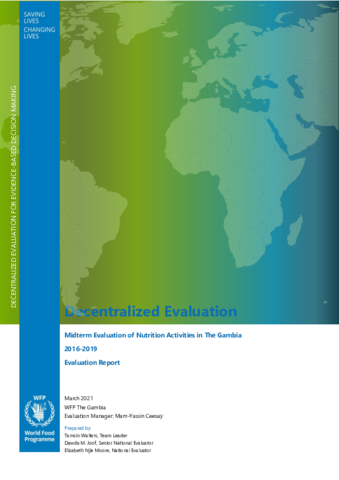
This decentralised evaluation was commissioned by WFP The Gambia Country Office and covers all nutrition activities implemented from January 2016 to December 2019 across the four provincial regions of the country, under three sequential programmatic frameworks.
The evaluation was designed according to the following international criteria: relevance, effectiveness, efficiency, impact and sustainability.
Overarching evaluation questions included:
- To what extent was the design of the nutrition activities relevant to the wider Gambian national context and in line with the needs of the most vulnerable groups?
- Was the intervention based on a sound gender analysis and the design and implementation gender-sensitive?
- To what extent were the outputs and outcomes of the nutrition interventions achieved? What were the major factors influencing the achievement or non-achievement?
- To what extent were the nutrition activities cost-efficient, implemented in a timely manner and in the most efficient way compared to alternatives?
- What were the effects of the nutrition activities on beneficiaries’ lives? Did a specific modality achieve a greater impact than other?
- To what extent did the nutrition activities implementation arrangements include considerations for sustainability, such as capacity strengthening? Is it likely that the benefits will continue after WFP work ceases?
Some of the activity-specific findings include the following:
• The school meal is playing a role in improving the nutritional status of children. The provision of a daily menu comprised of a diversity of nine locally sourced food items is a significant achievement.
• Improved synergy between programmes and joined up planning and/or implementation with others would likely have improved efficiency of the nutrition activities.
• There has been no gender analysis to inform the activity design which has an important role in achievement of nutrition outcomes, a strong focus on women for SBCC and engagement in activities has led to the importance of men’s roles being overlooked, potentially reducing the effectiveness of the SBCC approach.
• WFP’s capacity development efforts at the national level, bringing the private sector together around the SBN and the anticipated impact of the COHA in encouraging further prioritisation and resource mobilisation for nutrition have a significant likelihood of generating longer-term benefits beyond the timeframe of active WFP support.
• The impact of COVID-19 has changed the outlook on the long-term benefits of the nutrition activities considerably.
Key recommendations from the evaluation are:
R1: conduct a gender analysis examining power dynamics, with a focus on nutrition and understanding practices and norms that hinder achievement of nutrition outcomes.
R2: develop a strategic approach to nutrition capacity strengthening, based on a capacity gaps analysis.
R3: ensure the momentum of processes advanced by WFP’s efforts at national level (COHA, SBN, rice fortification) is not lost. Maintain a focus on advocacy.
R4: developed strategies to increase resilience of vulnerable households in preparation for the lean season and emergencies through improving access to and consumption of diverse diets.
R5: align TSF more closely with IMAM and SAM management.
R6: urgently address issue of transporter accountability mechanism for TSF and BSF.
R7: support the National Nutrition Agency (NaNa) to strengthen the biannual nutrition surveillance and to expand it to non-Primary Health Care communities.
R8: develop and enhance the SBCC approach for improved effectiveness and sustainability.
R9: improve provision and quality of nutrition education in schools.
R10: review the M&E plan and establish a system to more comprehensively and regularly monitor nutrition outcomes.
